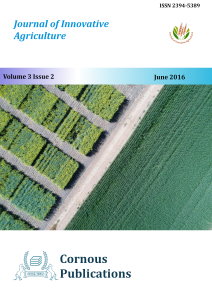
Journal of Innovative Agriculture
Peer Reviewed Open Access Journal
ISSN: 2394-5389 NAAS Rate: 4.05
Submit Manuscript
Peer Reviewed Open Access Journal
ISSN: 2394-5389 NAAS Rate: 4.05
Submit ManuscriptBhendi (Abelmoschus esculentus L. Moench) is an important warm season vegetable crop cultivated in India. It is the world’s largest producer of vegetables next to China. Among the vegetables grown extensively, bhendi found an important place due to their significant nutritional value. Phyllosphere microbes often have a direct positive influence in altering plant surface properties, where they may be involved in the fixation of nitrogen, promoting the growth of plants, control of plant pathogens or the degradation of organic pollutants. The present study was undertaken the microbial population and Azospirillum population in the phyllosphere region of bhendi. Five Azospirillum isolates were isolated from Bhendi Phyllosphere viz., BAZ 1, BAZ 2, BAZ 3, BAZ 4 and BAZ 5 and five strains were characterized as Azospirillum brasilense. These strains were screened for their N2 fixing efficiency and IAA production.
Bhendi, Phyllosphere, Azospirillum brasilense, N2 fixing efficiency, IAA production
Amirathalingam, S. (1988). Studies on the effect of Azospirillum, nitrogen and NAA growth and yield of chilli. South Indian Horticulture, 36:218.
Anajali Deshmukh, D.B.Matte and Bharthi Bhaisare. (1999). Fly ash as a source of plant nutrients and soil conditions. Jornal soils and Crops, 9(2): 276 – 279.
Baca, B.E., L. Soto - Urzua, Y.G. Xochihua and A. Cuervo – Garcia. (1994). Characterization of two aromatic amino acid aminotransferases and production of Indole acetic acid in Azospirillum strains. Soil Biol. Biochem., 26: 57- 63.
Bar, T. and Y. Okon. (1993) b. Induction of indole -3- acid synthesis and possible toxicity of tryptophan in Azospirillum brasilense Sp7. Sym. Rehovot., 13:191 – 198.
Bashan, Y. (1989). Nonspecific responses in plant growth, yield, and root colonization of noncereal crop plants to inoculation with Azospirillum brasilense. Cd. Can. J. Bot., 67:1317-1324.
Bashan, Y. and Hranony. (1990). Effect of bacterial inoculant on rice. Can. J. Microbiol., 36: 591.
Blum, B.J., (2007). Concepts and Strategies for a successful product Development: the industry development concept. In: Cost Action 850 – Conference Schloss Salzau, Germany.
Dart, P.J. (1986). Nitrogen associated with non-legumes in agriculture. Plant and Soil, 90: 303-304.
Deka , B.C., G.C. Bora and A. shadeque. (1992). Effect of Azospirillum on growth and yield of chilli (Capsicum annuum L.) cultivar pusa Jwala. Haryana J. Hort .,Sci., 38: 41 – 46.
Gomez, K.A.Gomez. (1984). Statistical procedure for Agricultural research. John Wiley and Sons, New York, Pp.140-156.
Hegazi,N.M. Eid, R.S. farag and M.Monih. (1979). A symbiotic nitrogen fixation in rhizosphere of sugarcane planted under semi arid condition of Egypt. Rev. Ecol. Biol. Soil, 16 : 23 – 37.
Humphries, E.C. (1956). Mineral components and analysis: Modern methods of plant analysis. Springer-Verlag, Berlin. pp. 468-502.
Lindow SE, Brand MT. (2003). Microbiology of the phyllosphere. Appl. Environ. Microbiol., 69: 1875-1883.
Lindow SE, Leveau JH. (2002). Phyllosphere Microbiology. Curr. Opin. Biotechnol., 31: 238-243.
Naver, G., A. Kronenberg and H. Bothe . (1985). Denitrification and nitrogen fixation by Azospirillum. Arch Microbiol., 141: 364 – 370.
Okon, Y.,Y .Kapulnik and S. Sarig. (1988). Field inoculation studies with Azospirillum in Israel. In: Biological Nitrogen Fixation: Recent Developments (ed.) Subba Rao, N.S. oxford and I.B.H. Publishing Company, New Delhi.pp.175-195.
Parvatham, A., K .P. vijayan and A. nazar. (1989). Effect of Azospirillum on growth and nutrient uptake of Pusa Sawani bhendi. South Indian Horti., 37(4) : 227 – 229.
Sharma, N.K. and P.L.Bhalla. (1986). Influence of integrated nutrient management on growth field and economics of okra (Abelmoschus esculentus L.). Veg.Sc., 22(1):1-4
Tapia- Hernander, A., Mascarua and J. Caballeso. (1990). Production of bacteriocins and siderophore – like activity by Azospirillum brasilense. Microbiol., 64: 73 – 83.
Zimmer, W.C. H.Elmerich, H.Hennecke and D.D.S. Verma. (1991). Regulation of the synthesis of indole-3-acetic acid in Azospirillum. Adv. Mole Gene. Plant Microbe Int., 11: 465-468.
